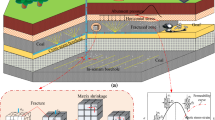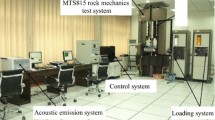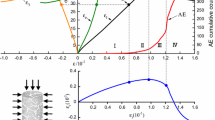Abstract
Before a coal mining operation, it is necessary to carry out coal-bed methane (CBM) pre-extraction to prevent coal and gas explosions, causing accidents. However, gas extraction and coal mining will lead to coal damage, which results in a change in the gas migration law. Especially, under deep mining conditions, the gas migration mechanism is more complicated owing to a high ground temperature. Coal permeability is the most important constituent that determines gas flow properties. Therefore, the coal permeability evolutionary law related to damage-induced conditions under different temperatures should be further researched. In this paper, a series of triaxial seepage experiments during the whole stress-induced process, and in the changing of the effective stress process were carried out. The results have shown that during the whole stress–strain process, with an increase in axial strain, coal permeability gradually decreases to a minimum value at first, then increases sharply, and finally keeps nearly constant. A higher temperature resulted in a lower elastic modulus, peak strain, and peak strength, but it caused higher thermal damage. When the coal fractures, coal permeability increases with the increase in temperature. During a change in the effective stress process, higher temperatures resulted in higher permeability. Under higher effective stress, the impact of temperature on permeability was not significant. Based on the above results, a novel damage-based permeability model was developed to describe the permeability evolutionary law caused by damage-induced conditions under compaction, and in a fracturing situation. In the proposed model, an exponential function has been used for the combination between permeability and damage variable. The damage variable is composed of thermal damage and mechanical damage. In addition, the damage variable has been modified by introducing a modified function of the initial damage. Finally, the proposed model has been applied to fit two sets of experimental data available. The fitting results showed that the proposed permeability model could well reflect the permeability behaviors of damage-induced coal at different temperatures.














Similar content being viewed by others
Abbreviations
- a :
-
Coal cleat spacing (cm)
- A :
-
Cross section area (cm2)
- Aa :
-
Pre-exponential coefficient (cm3/g)
- A 0 :
-
Permeability area of the specimen (cm2)
- b :
-
Coal cleat aperture (cm)
- B :
-
Constitutive coefficient
- c :
-
Maximum adsorption amount (mmol/g)
- d :
-
Langmuir constant (MPa−1)
- DT :
-
Thermal damage
- D m :
-
Mechanical damage variable
- E :
-
Elastic moduli of the equivalent coal (MPa)
- E A :
-
The modulus of adsorption-induced expansion of coal (MPa)
- E m :
-
Elastic moduli of the coal matrix (MPa)
- E T :
-
Elastic moduli at temperature T (MPa)
- E 0 :
-
Elastic moduli at room temperature (MPa)
- E a :
-
Adsorption-induce energy (kJ/mol)
- f s :
-
Total cleat length per unit cross section (cm−1)
- f c 0 :
-
Compressive strength (MPa)
- I d :
-
Initial damage coefficient
- k :
-
Coal permeability (10–3 μm2)
- k f :
-
Coal cleat permeability (10–3 μm2)
- l :
-
Coal cleat height (cm)
- l m :
-
Coal matrix width (cm)
- L :
-
Coal matrix length (cm)
- L 0 :
-
Length of specimen (cm)
- p :
-
Gas pressure (MPa)
- p 0 :
-
Initial gas pressure (MPa)
- p 1 :
-
Inlet gas pressure (MPa)
- p 2 :
-
Outlet gas pressure (MPa)
- peff :
-
Effective confining pressure (MPa)
- p p :
-
Pore pressure (MPa)
- P 0 :
-
Standard atmospheric pressure (MPa)
- q 1 :
-
Flow rate through this single cleat (cm3/s)
- q n :
-
Flow rate through n cleats (cm3/s)
- Q :
-
Gas flow rate (cm3/s)
- R :
-
Universal gas constant
- R m :
-
Elastic modulus reduction ratio
- S :
-
Specific surface area of the solid (m2/g)
- T :
-
Temperature (K)
- u :
-
Displacement of the coal matrix (cm)
- u*:
-
Displacement of the equivalent coal (cm)
- V :
-
Gas volume adsorbed by coal (cm3)
- V 0 :
-
Gas molar volume (L/mol)
- V abs :
-
Gas absolute volume adsorbed by coal (cm3
- ϕ f :
-
Coal cleat porosity
- φ :
-
Internal friction angle (°)
- μ :
-
Gas dynamic viscosity (Pa·S)
- γ :
-
Deformation constant
- γ d :
-
Damage-permeability coefficient
- ρ c :
-
Solid body density (g/cm3)
- λ c :
-
Residual strength coefficient
- Γ :
-
Surface excess (mol/m2)
- ε s :
-
Adsorption volumetric strain
- Δεe :
-
Effective strain
- Δεf :
-
Cleat strain
- Δεtx :
-
Total strain in x or y direction
- ε 1 :
-
Axial strain
- ε c 0 :
-
Peak strain
- ε cr :
-
Residual strain
- ε cu :
-
Maximum residual strain
- σ 1 :
-
Axial stress (MPa)
- σ 3 :
-
Confining pressure (MPa)
- Δσ :
-
Deviatoric stress (MPa)
- Δσe :
-
Effective stress (MPa
References
Adhikary DP, Guo H (2014) Measurement of longwall mining induced strata permeability. Geotech Geol Eng 32:617–626
Bangham DH, Fakhoury N (1931) The translation motion of molecules in the adsorbed phase on solids. J Chem Soc 1324–1333
Bary B (2011) Estimation of poromechanical and thermal conductivity properties of unsaturated isotropically microcracked cement pastes. Int J Numer Anal Methods Geomech 35:1560–1586
Chow CL, Wang J (1987) An anisotropic theory of elasticity for continuum damage mechanics. Int J Fract 33:3–16
Chaki S, Takarli M, Agbodjan WP (2008) Influence of thermal damage on physical properties of a granite rock: porosity, permeability and ultrasonic wave evolutions. Constr Build Mater 22(7):1456–1461
Charrière D, Pokryszka Z, Behra P (2010) Effect of pressure and temperature on diffusion of CO2 and CH4 into coal from the lorraine basin (france). Int J Coal Geol 81(4):373–380
Charoensuppanimit P, Mohammad SA Jr, RLR, Gasem KAM, (2015) Modeling the temperature dependence of supercritical gas adsorption on activated carbons, coals and shales. Int J Coal Geol 138:113–126
Chen D, Pan ZJ, Liu JS, Connell LD (2012) Characteristic of anisotropic coal permeability and its impact on optimal design of multi-lateral well for coalbed methane production. J Pet Sci Eng 88:13–28
Chen HD, Cheng YP, Zhou HX, Li W (2013) Damage and permeability development in coal during unloading. Rock Mech Rock Eng 46(6):1377–1390
Chen D, Pan Z, Shi JQ, Si GY, Ye ZH, Zhang JL (2016) A novel approach for modelling coal permeability during transition from elastic to post-failure state using a modified logistic growth function. Int J Coal Geo 163:132–139
Chen X, Yu J, Tang CA, Li H, Wang SY (2017) Experimental and numerical investigation of permeability evolution with damage of sandstone under triaxial compression. Rock Mech Rock Eng 50(6):1529–1549
Cui GL, Wei J, Feng XT, Liu JS, Elsworth D, Chen T, Xiong W (2019) Preliminary study on the feasibility of co-exploitation of coal and uranium. Int J Rock Mech Min Sci 123:104098
Dabbous MK, Reznik AA, Taber JJ, Fulton PF (1974) The permeability of coal to gas and water. SPE J 14:563–572
Darot M, Reuschlé T (2000) Acoustic wave velocity and permeability evolution during pressure cycles on a thermally cracked granite. Int J Rock Mech Min Sci 37(7):1019–1026
Darabi H, Ettehad A, Javadpour F, Sepehrnoori K (2012) Gas flow in ultra-tight shale strata. J Fluid Mech 710:641–658
Dragon A, Halm D, Desoyer T (2000) Anisotropic damage in quasi-brittle solids: modelling, computational issues and applications. Comput Method Appl M 183:331–352
Durucan S, Edwards JS (1986) The effects of stress and fracturing on permeability of coal. Min Sci Technol 3:205–216
Espinoza DN, Vandamme M, Pereira JM, Dangla P, Vidal-Gilbert S (2014) Measurement and modeling of adsorptive–poromechanical properties of bituminous coal cores exposed to CO2: adsorption, swelling strains, swelling stresses and impact on fracture permeability. Int J Coal Geo 134:80–95
Gough C, Shackley S, Cannell MG (2002) Evaluating the options for carbon sequestration. Tyndall Centre for Climate Change Research, Norwich
Gao C, Xie LZ, Xie HP, He B, Li CB, Wang J, Luo Y (2017) Coupling between the statistical damage model and permeability variation in reservoir sandstone: theoretical analysis and verification. J Nat Gas Sci Eng 37:375–385
Harpalani S, Chen GL (1997) Influence of gas production induced volumetric strain on permeability of coal. Geotech Geol Eng 15(4):303–325
Heller R, Vermylen J, Zoback M (2014) Experimental investigation of matrix permeability of gas shales. AAPG Bull 98:975–995
Jiang T, Shao JF, Xu WY, Zhou CB (2010) Experimental investigation and micromechanical analysis of damage and permeability variation in brittle rocks. Int J Rock Mech Min Sci 47:703–713
Karacan CO (2007) Development and application of reservoir models and artificial neural networks for optimizing ventilation air requirements in development mining of coal seams. Int J Coal Geol 72(3):221–239
Levine JR (1996) Model study of the influence of matrix shrinkage on absolute permeability of coal bed reservoirs. Geol Soc London Spec Publ 109(01):197–212
Li BB, Yang K, Ren CH, Li JH, Xu J (2019) An adsorption-permeability model of coal with slippage effect under stress and temperature coupling condition. J Nat Gas Sci Eng 71:102983
Li BB, Ren CH, Wang ZH, Li JH, Yang K, Xu J (2020) Experimental study on damage and the permeability evolution process of methane-containing coal under different temperature conditions. J Pet Sci Eng 184:106509
Liu JS, Chen ZW, Elsworth D, Miao XX, Mao XB (2010) Linking gas-sorption induced changes in coal permeability to directional strains through a modulus reduction ratio. Int J Coal Geol 83(1):21–30
Liu HH, Rutqvist J (2010) A new coal-permeability model: internal swelling stress and fracture–matrix interaction. Transp Porous Media 82(1):157–171
Liu J, Chen ZW, Elsworth D, Qu HY, Chen D (2011a) Interactions of multiple processes during CBM extraction: a critical review. Int J Coal Geol 87:175–189
Liu JS, Chen ZW, Elsworth D, Miao XX, Mao XB (2011b) Evolution of coal permeability from stress-controlled to displacement-controlled swelling conditions. Fuel 90(10):2987–2997
Liu SM, Harpalani S (2013) A new theoretical approach to model sorption-induced coal shrinkage or swelling. Aapg Bulletin 97(7):1033–1049
Liu ZD, Cheng YP, Dong J, Jiang JY, Wang L, Li W (2018) Master role conversion between diffusion and seepage on coalbed methane production: implications for adjusting suction pressure on extraction borehole. Fuel 223:373–384
Liu LY, Ji HG, Elsworth D, Zhi S, Lv XF, Wang T (2020) Dual-damage constitutive model to define thermal damage in rock. Int J Rock Mech Min Sci 126:104185
Lu SQ, Zhang YL, Sa ZY, Si SF, Shu LY, Wang L (2019) Damage‐induced permeability model of coal and its application to gas predrainage in combination of soft coal and hard coal. Energy Sci Eng
Maggs FAP (1946) The adsorption-swelling of several carbonaceous solids. Trans Faraday Soc 42:B284–B288
Moffat DH, Weale KE (1955) Sorption by coal of methane at high pressures. Fuel 34(04):449–462
Olivier JGJ, Aardenne JAV, Dentener FJ, Pagliari V, Ganzeveld LN, Peters JAHW (2005) Recent trends in global greenhouse gas emissions: regional trends 1970–2000 and spatial distribution of key sources in 2000. Environ Sci 2(2–3):81–99
Pan ZJ, Connell LD (2012) Modelling permeability for coal reservoirs: a review of analytical models and testing data. Int J Coal Geol 92:1–44
Pensée V, Kondo D, Dormieux L (2002) Micromechanical analysis of anisotropic damage in brittle materials. J Eng Mech 128:889–897
Perera MSA, Ranjith PG, Choi SK, Airey D (2012) Investigation of temperature effect on permeability of naturally fractured black coal for carbon dioxide movement: an experimental and numerical study. Fuel 94:596–605
Qu HY, Liu JS, Chen ZW, Wang JG, Pan ZJ, Connell L, Elsworth D (2012) Complex evolution of coal permeability during CO2 injection under variable temperatures. Int J Greenhouse Gas Control 9:281–293
Sakurovs R, Day S, Weir S, Duffy G (2008) Temperature dependence of sorption of gases by coals and charcoals. Int J Coal Geol 73(3):250–258
Shao JF, Zhou H, Chau KT (2005) Coupling between anisotropic damage and permeability variation in brittle rocks. Int J Numer Anal Methods Geomech 29:1231–1247
Shang XJ, Wang JG, Zhang ZZ, Gao F (2019) A three-parameter permeability model for the cracking process of fractured rocks under temperature change and external loading. Int J Rock Mech Min Sci 123:104106
Siriwardane HJ, Gondle RK, Smith DH (2009) Shrinkage and swelling of coal induced by desorption and sorption of fluids: theoretical model and interpretation of a field project. Int J Coal Geol 77:188–202
Somerton WH, Söylemezoglu IM, Dudley RC (1975) Effect of stress on permeability of coal. Int J Rock Mech Min Sci Geomech Abstr 12:129–145
Souley M, Homand F, Pepa S, Hoxha D (2001) Damage-induced permeability changes in granite: a case example at the URL in Canada. Int J Rock Mech Min Sci 38:297–310
Tang X, Ripepi N, Stadie NP, Yu L, Hall MR (2016) A dual-site langmuir equation for accurate estimation of high pressure deep shale gas resources. Fuel 185:10–17
Tan YL, Pan ZJ, Liu JS, Zhou FB, Connell LD, Sun WJ (2018) Experimental study of impact of anisotropy and heterogeneity on gas flow in coal. Part II: permeability fuel 230:397–409
Tvergaard V, Nielsen KL (2010) Relations between a micro-mechanical model and a damage model for ductile failure in shear. J Mech Phys Solids 58:1243–1252
Wang GX, Wei XR, Wang K, Massarotto P, Rudolph V (2010) Sorption-induced swelling/shrinkage and permeability of coal under stressed adsorption/desorption conditions. Int J Coal Geol 83(1):46–54
Wang K, Zang J, Wang GD, Zhou AT (2014) Anisotropic permeability evolution of coal with effective stress variation and gas sorption: model development and analysis. Int J Coal Geol 130:53–65
Wang EY, Kong XG, Hu SB, Li ZH, Liu QL (2018a) Multi-scale fractured coal gas-solid coupling model and its applications in engineering projects. Transp Porous Media 121(3):703–724
Wang JG, Hu BW, Liu H, Han Y, Liu J (2018b) Effects of ‘soft-hard’ compaction and multiscale flow on the shale gas production from a multistage hydraulic fractured horizontal well. J Pet Sci Eng 170:873–887
Wang LS, Chen ZW, Wang CG, Elsworth D, Liu WT (2019) Reassessment of coal permeability evolution using steady-state flow methods: the role of flow regime transition. Int J Coal Geol 211:103210
Wei MY, Liu JS, Elsworth D, Li SJ, Zhou FB (2019) Influence of gas adsorption induced non-uniform deformation on the evolution of coal permeability. Int J Rock Mech Min Sci 114:71–78
Xie HP, Xie J, Gao MZ, Zhang R, Zhou HW, Gao F, Zhang ZT (2015) Theoretical and experimental validation of mining-enhanced permeability for simultaneous exploitation of coal and gas. Environ Earth Sciences 73(10):5951–5962
Xu H, Arson C (2014) Anisotropic damage models for geomaterials: theoretical and numerical challenges. Int J Comp Meth Sing 11:430–445
Xu XL, Karakus M (2018) A coupled thermo-mechanical damage model for granite. Int J Rock Mech Min Sci 103:195–204
Xue Y, Gao F, Liu XG (2015) Effect of damage evolution of coal on permeability variation and analysis of gas outburst hazard with coal mining. Nat Hazards 79(2):999–1013
Xue Y, Gao F, Gao YA, Cheng HM, Liu YK, Hou P, Teng T (2016) Quantitative evaluation of stress-relief and permeability-increasing effects of overlying coal seams for coal mine methane drainage in Wulan coal mine. J Nat Gas Sci Eng 32:122–137
Xue Y, Dang FN, Cao ZZ, Du F, Ren J, Chang X, Gao F (2018) Deformation, permeability and acoustic emission characteristics of coal masses under mining-induced stress paths. Energies 11(9):2233
Yavuz H, Demirdag S, Caran S (2010) Thermal effect on the physical properties of carbonate rocks. Int J Rock Mech Min Sci 47(1):94–103
Yu J, Chen X, Li H, Zhou JW, Cai YY (2015) Effect of freeze-thaw cycles on mechanical properties and permeability of red sandstone under triaxial compression. J Mt Sci 12(1):218–231
Zhu WC, Wei CH (2010) Numerical simulation on mining-induced water inrushes related to geologic structures using a damage-based hydromechanical model. Environ Earth Sci 62(1):43–54
Zhang ZT, Zhang R, Xie HP, Gao MZ, Xie J (2016) Mining-induced coal permeability change under different mining layouts. Rock Mech Rock Eng 49(9):3753–3768
Zhang XM, Zhang DM, Leo CJ, Yin GZ, Feng D, Liyanapathirana DS (2017a) Damage evolution and post-peak gas permeability of raw coal under loading and unloading conditions. Transp Porous Media 117(3):465–480
Zhang ZT, Zhang R, Xie HP, Gao MZ, Zha ES, Jia ZQ (2017b) An anisotropic coal permeability model that considers mining-induced stress evolution, microfracture propagation and gas sorption-desorption effects. J Nat Gas Sci Eng 46:664–679
Zheng CS, Kizil MS, Chen ZW, Aminossadati SM (2018) Role of multi-seam interaction on gas drainage engineering design for mining safety and environmental benefits: Linking coal damage to permeability variation. Process Saf Environ Prot 114:310–322
Zhou YB, Li ZH, Yang YL, Zhang LJ, Si LL, Kong B, Li JH (2016) Evolution of coal permeability with cleat deformation and variable Klinkenberg effect. Transp Porous Media 115(1):153–167
Acknowledgements
This study was financially supported by the National Natural Science Foundation of China (Grants No. 51804085, 51911530203 and 51874144), Guizhou Science and Technology Department (No. J2015-2049).
Author information
Authors and Affiliations
Corresponding author
Ethics declarations
Conflict of interest
The authors have declared that we have no financial and personal relationships with other people or organizations that can inappropriately influence our work.
Additional information
Publisher's Note
Springer Nature remains neutral with regard to jurisdictional claims in published maps and institutional affiliations.
Rights and permissions
About this article
Cite this article
Ren, C., Li, B., Xu, J. et al. A Novel Damage-Based Permeability Model for Coal in the Compaction and Fracturing Process Under Different Temperature Conditions. Rock Mech Rock Eng 53, 5697–5713 (2020). https://doi.org/10.1007/s00603-020-02236-7
Received:
Accepted:
Published:
Issue Date:
DOI: https://doi.org/10.1007/s00603-020-02236-7




